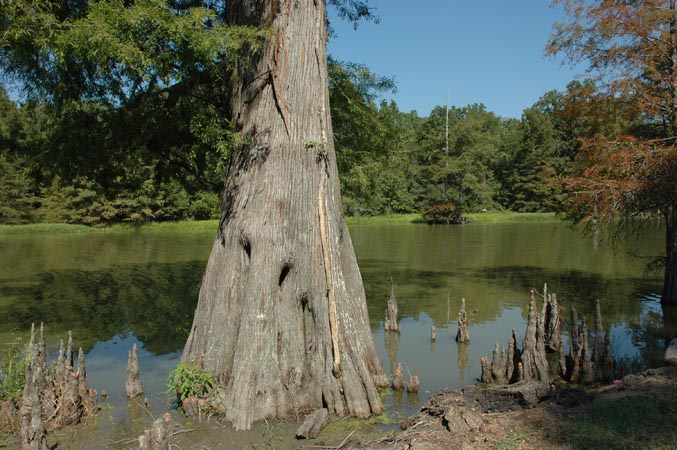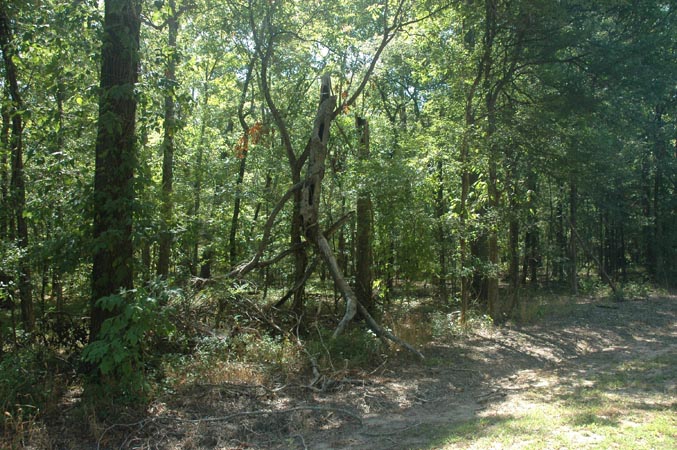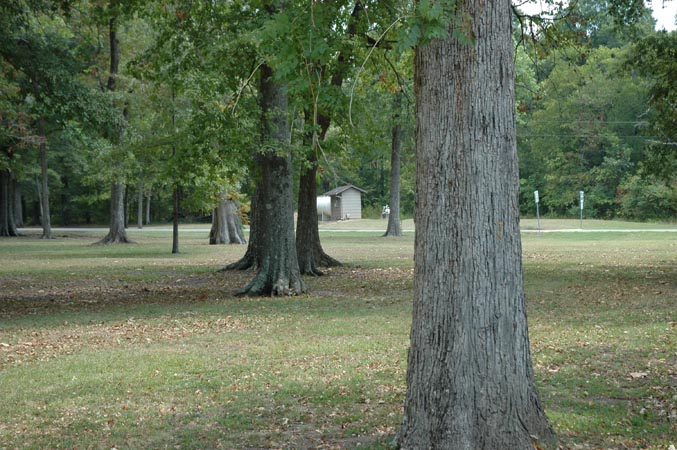Ants in Leroy Percy State Park, Washington County, Mississippi [MS State Park Ants]
Joe A. MacGown and JoVonn G. Hill
uploaded 21 August 2006
Leroy Percy State Park is located five miles west of Hollandale in Washington County, Mississippi. This is the oldest state park in Mississippi, a fact which is illustrated by some of the huge hardwood and cypress trees present. Warm artesian springs in the park are inhabited by alligators. The park is also home to other wildlife such as turkey, deer, squirrel, ducks, and doves. The park boasts a wildlife preserve and hunting is open during the appropriate seasons. Several cabins and campsites are available for those wishing to spend some time at the park.
We arrived at Leroy Percy State Park in the morning of 17 August 2006. We first checked in at the office to give them a heads up that we would be collecting ants. After talking to a ranger, we headed out to collect some ants. We drove around a bit and soon decided to begin our collections at the beginning of a nature trail that bordered the lake (33°10'16"N90°56'12"W). The air was already thick with humidity and unpleasantly hot, and most of the area was extremely dry. Near the beginning of the trail was a beautiful, albeit small, lake, which was bordered by large cypress trees, and signs that said not to feed the alligators. This sign was not to be taken lightly, a fact noted by Joe as he was collecting at the base of a large tree beside the lake when a large alligator casually swam toward him to investigate what manner of animal was rooting around in the soil. Fortunately, the gator was only curious, and no serious harm came to either the alligator or Joe.

A beautiful old cypress tree, one of many found along the edge of the lake.
The nature trail ran through an old bottomland forest, which was undoubtedly much drier than was normal. This was apparent right away as the trail was crisscrossed with large, deep cracks. The soil in the woods on either side of the trail was dry and sifting soil and leaf litter for ants was like sifting dust in much of the forest. Judging from the water marks on some of the trees, this area was sometimes actually partially underwater. However, we managed to find at least a few pockets here and there where the soil was not quite as dry, especially near the lake. Not surprisingly it was in those areas that we had the best luck in our ant collecting endeavors. That is not to say that no ants were found in even the driest of spots, but the diversity in those areas was much lower.
Of course, as we made our way into the woods from an open grassy area we spotted colonies of the red imported fire ant, Solenopsis invicta Buren. Somewhat atypically, we also found fire ants throughout the forest nesting in soil and in logs. The much smaller, but related thief ants, Solenopsis sp. cf. molesta (Say), were found nesting in the soil and litter throughout the forest. These little yellow ants apparently had no trouble dealing with the dry conditions, and appeared to one of the more abundant species here.
Only two species from the subfamily Formicinae, Lasius americanus Emery and Camponotus pennsylvanicus (DeGeer) were collected in the forest. These are both extremely common, dark colored species that prefer forested landscapes. Lasius alienus is typically found in bottomland, swampy, or otherwise wet forests, and it was no exception here, as they were found in the slightly wetter areas near the lake. Camponotus pennsylvanicus, otherwise known as the black carpenter ant, is a large black species that is widespread in the eastern U.S. This species is considered to be a structural pest that invades and nests in the woodwork of man-made structures.

Near the beginning of the nature trail.
Two very common dark brown ponerine ants, Hypoponera opacior (Forel) and Ponera pennsylvanica Buckley, were collected in leaf litter. We have found these small, somewhat elongate ants in virtually every wooded habitat we have searched in this region. Another related ant, Proceratium silaceum Roger, in the subfamily Proceratiinae, was also found in the litter in an area that was near the lake. This reddish-brown species is more uncommon and we were glad to find it.
Several common myrmicine ants proved to be hardy enough to withstand the high temperatures and dry conditions. Only one species of Pheidole, P. dentata Mayr, was collected at the site, and it too, was fairly abundant. This common species was found in both logs and in soil at the bases of hardwood trees. One of the acrobat ants, Crematogaster pilosa Emery, was also found here and there in the woods nesting in small pieces of wood on the ground. Workers of a smaller, related species, C. ashmeadi Mayr, were collected as they crawled on trees. Several workers of the dark Myrmica punctiventris Roger were collected in litter. This is an average sized, dark colored species with long spines that was only recently reported as occurring in the state (MacGown and Brown, in press). A few workers of another dark colored species of similar size, but with smaller spines, Aphaenogaster miamiana Wheeler, was also found in the litter. This was the only Aphaenogaster species that we found, which was surprising, as this is usually a very common species in woods and they are usually easy to find. A slightly smaller species, also with dark coloration and short spines, Temnothorax pergandei Emery, was collected here as well. The shiny, black, bispinose Myrmecina americana Emery was found at bases of trees in the soil and litter. This is a common ant that we have found throughout wooded habitats in the region. Yet another dark species, Monomorium minimum (Buckley), also called the little black ant, was discovered in the litter at bases of trees and was also seen foraging on the ground and on trees. This minute species also invades houses and is considered a nuisance pest. It is interesting that all of the common ants we collected from the Myrmicinae subfamily were dark in color, ranging in color from dark brownish-black to black.
Although most of the ants we collected from the state park were very common species, we actually did quite well with the tribe Dacetini, which in the subfamily Myrmicinae. Members of this group are minute, cryptic, soil and litter dwelling ants that are specialized predators of various small organisms, especially collembolans. We collected eight species of Strumigenys: S. creightoni (M. R. Smith), S. hyalina Bolton, S. louisianae Roger, S. ohioensis Kennedy & Schramm, S. ornata Mayr, S. pilinasis (Forel), S. pulchella Emery, and S. talpa Weber . Most of these species are only infrequently collected, with the exception of S. ohioensis and S. ornata, which we have found with regularity throughout the state.
Before leaving the park we stopped at a picnic area near the office, where we ate lunch (33°09'56"N90°56'11"W). While we were there, we collected some ants. For the most part the ants we found there were run of the mill species that we had already collected at the other site, and included Camponotus snellingi Bolton, Monomorium minimum, Solenopsis invicta, and Crematogaster ashmeadi. Camponotus snellingi was the only species that we didn't collect at the other site, and we found workers of this species crawling on tree trunks. It is quite different in appearance from C. pennsylvanicus, being mostly reddish-brown except for the last few segments of the gaster, which are black; very shiny; and smaller in size.

The picnic area.
Discussion
Although only 26 species of ants were collected at the park, the number of ants occurring there is likely much higher. At the time of our collections, we were in a serious drought throughout much of the state, and the park here was no exception. This was quite obvious as we walked along the nature trail through a bottomland hardwood forest. This area is typically fairly wet, as was clearly evident by the various raised wooden walkways and water marks on trees. However, on this occasion, much of the soil was quite dry, and the trail was riddled with large cracks. Not surprisingly, the most interesting ants we found were in an area near the lake, which still had some moist soil present.
Most of the ants we collected in the park were relatively common species that we would expect to find in many forested habitats in Mississippi. But, there were a few species that are considered to be uncommon or rarely collected. By far the most interesting species we found was Strumigenys hyalina, which is only known from two other states (Indiana and Ohio) from a handful of specimens (MacGown et al, 2005). In Mississippi, this species has been collected in Stoneville, in Washington Co., and at the Noxubee National Wildlife Refuge in Oktibbeha Co. Interestingly, the habitat at all three of the localities were this species has been collected is bottomland hardwood forest. Strumigenys pilinasis is another species that we have only collected rarely in the state, although it has a much wider distribution in the U.S. Strumigenys ohioensis and Strumigenys talpa were only recently discovered to occur in MS (MacGown et al, 2005), although we do not consider these species to be rare and have collected them in many different localities in the state.
In our search for ants, we found very few individuals of Aphaenogaster, and only one species. This was unusual because we typically find many colonies and usually three or four species in forested habitats. The species we did find was very dark colored and appeared to be Aphaenogaster miamiana, a species we usually find in the southern portion of the state. However, we have found this species in other counties in the delta, and apparently its distribution in MS follows a curve including the southern third or so of the state then extending northward along the MS River to at least Washington County. Although we didn't collect any other species of Aphaenogaster from the park, we had specimens of Aphaenogaster carolinensis (Wheeler) and Aphaenogaster fulva Roger in the Mississippi Entomological Museum that were collected from the park from the previous year.
List of ant species collected (arranged alphabetically by genus)
Aphaenogaster carolinensis (Wheeler) (not collected on this trip)
Aphaenogaster fulva Roger (not collected on this trip)
Aphaenogaster miamiana Wheeler
Camponotus pennsylvanicus (DeGeer)
Camponotus snellingi Bolton
Crematogaster ashmeadi Mayr
Crematogaster pilosa Emery
Hypoponera opacior (Forel)
Lasius americanus Emery
Monomorium minimum (Buckley)
Myrmecina americana Emery
Myrmica punctiventris Roger
Pheidole dentata Mayr
Ponera pennsylvanica Buckley
Proceratium silaceum Roger
Solenopsis invicta Buren
Solenopsis sp. cf. molesta (Say)
Strumigenys creightoni (M. R. Smith)
Strumigenys hyalina (Bolton)
Strumigenys louisianae Roger
Strumigenys ohioensis Kennedy & Schramm
Strumigenys ornata Mayr
Strumigenys pilinasis Forel
Strumigenys pulchella Emery
Strumigenys talpa Weber
Temnothorax pergandei Emery
MacGown, J. A., R. L. Brown, and J. G. Hill. 2005. An annotated list of the Pyramica (Hymenoptera: Formicidae: Dacetini) of Mississippi. Journal of the Kansas Entomological Society 78: 285–289. [pdf]
MacGown, J. A. and R. L. Brown. 2006. Survey of Ants (Hymenoptera: Formicidae) of the Tombigbee National Forest in Mississippi. Kansas Entomological Society 79: 325-340. [pdf]


